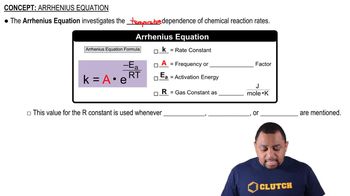Here are the essential concepts you must grasp in order to answer the question correctly.
Activation Energy
Activation energy is the minimum energy required for a chemical reaction to occur. It represents the energy barrier that reactants must overcome to transform into products. This concept is crucial for understanding reaction rates, as higher activation energies typically lead to slower reactions, while lower activation energies facilitate faster reactions.
Recommended video:
Rate Law
The rate law expresses the relationship between the rate of a chemical reaction and the concentration of its reactants. It is typically formulated as rate = k[A]^m[B]^n, where k is the rate constant, and m and n are the reaction orders with respect to reactants A and B. Understanding the rate law is essential for analyzing how changes in concentration affect the reaction rate and for determining the activation energy.
Recommended video:
Arrhenius Equation
The Arrhenius equation relates the rate constant of a reaction to its activation energy and temperature. It is expressed as k = A * e^(-Ea/RT), where A is the pre-exponential factor, Ea is the activation energy, R is the universal gas constant, and T is the temperature in Kelvin. This equation is fundamental for calculating activation energy from experimental rate data, as it shows how temperature influences reaction rates.
Recommended video:




